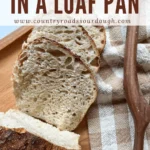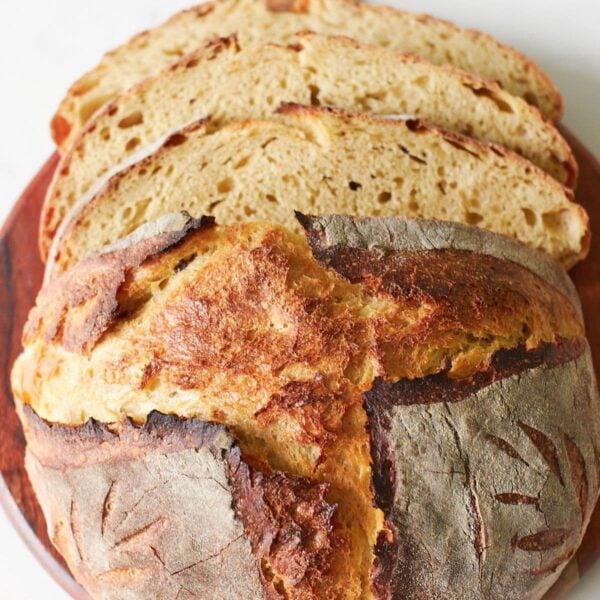Sourdough Bread in a Loaf Pan (no dutch oven required)
Apr 18, 2024, Updated Apr 17, 2025
This post may contain affiliate links . Read my full Disclosure Policy.
Did you know you could make sourdough bread in a loaf pan? It’s true—you don’t have to have a dutch oven to make delicious artisan sourdough bread. Loaf pan sourdough bread is a great everyday option and is perfect for getting uniform slices of bread for sandwiches and toast. It still has the signature crispy crust (if you want it) with a soft interior. Typically, the crumb will be tighter, but if you are making sandwiches anyway, it’s ideal! It’s a great option for beginners who aren’t ready to invest in a dutch oven and are looking to keep things as simple as possible.
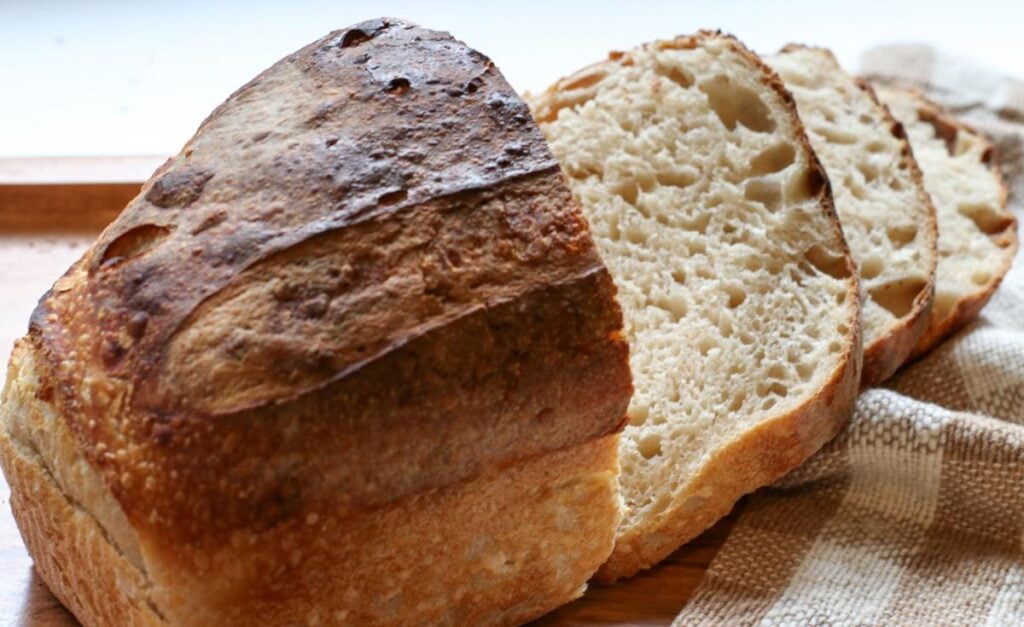
Table of Contents
- Here’s why you’ll love baking sourdough in a loaf pan:
- Overproofed dough?
- What size and type of pan should you use?
- Let’s make minis!
- Baking sourdough bread with steam
- Electric vs Gas Ovens
- Helpful tools
- How to make sourdough in a loaf pan
- Sample Baking Schedule
- How to store and freeze loaf pan sourdough bread
- Loaf Pan Sourdough Bread Recipe
Here’s why you’ll love baking sourdough in a loaf pan:
- Hides imperfections: You may or may not have made sourdough in a dutch oven before, but if you have, you’ll know how important shaping and proofing times are to your bake. Too long of a proof, and your loaf ends up flat and misshapen. The confined edges of a loaf pan force the loaf to rise up and helps conceal any mistakes.
- Uniform and easy to slice: Loaf pan sourdough is especially great for sandwiches!
- More accessible and affordable: Let’s be honest, dutch ovens can be a bit of an investment and also take up a lot of room, so you may not be ready to make that commitment yet. Most people already have a loaf pan at home, so it makes it easy.
- Beginner-friendly: Shaping is not as important for sourdough in a loaf pan because the pan provides structure for the dough making this bake stress-free.
- No need for proofing baskets: The second proof is performed in the loaf pan followed by the bake, so there’s no need for a proofing basket.
Overproofed dough?
If you’ve ever been baking sourdough and went to flip your dough out of the proofing basket to find the dough immediately loses its shape and bakes flat, you know how frustrating that is. Baking sourdough bread in a loaf pan is a simple fix for overproofed dough. What happens is when the dough sits for too long, the dough becomes very aerated and the gluten strands wear out. The loaf pan is a good solution because it provides the dough structure and support and forces it to rise up instead of out.
What size and type of pan should you use?
Aluminum or metal pans are going to be the ideal choice for loaf pan sourdough bread. Glass is not ideal as it is not able to withstand the higher baking temperatures. As far as the size goes, I use a 1-pound loaf pan that measures 8.5 x 4.5 x 2.75 inches. You can get away with one that is slightly bigger, but I wouldn’t recommend going smaller. Here’s my favorite loaf pan. This is the same pan that I use to make my Sourdough Sandwich Bread, and quick breads such as Sourdough Zucchini Bread, Sourdough Pumpkin Bread, or Sourdough Banana Bread.
Let’s make minis!

You know what’s even better than sourdough in a loaf pan? Sourdough in MINI loaf pans. Mini sourdough loaves allow you to try different flavors and add-ins without having to make multiple large loaves. Want to share your sourdough love with your friends and family? Make mini loaves to share or to give as gifts! They are also the perfect solution for someone who lives alone or who doesn’t eat as much bread.
Check out my blog post for all the details on mini sourdough loaves.
Baking sourdough bread with steam
Steam is an essential part of baking sourdough bread because of the high temperatures it is baked at. If the loaf was to bake at high temperatures without steam, the outside of the loaf would harden before it could finish rising. When baking sourdough bread in a dutch oven, the moisture from the dough is trapped inside, which keeps the crust soft so the loaf is able to fully rise. To mimic this without the use of a dutch oven, we will use ice cubes on a sheet pan. As the ice cubes come in contact with the heat, they create steam which keeps the crust soft.
Electric vs Gas Ovens
Electric and gas ovens are not treated equally when it comes to open baking sourdough in a loaf pan. Gas ovens vent the steam quicker than electric ovens, which can cause issues with open baking. While some have found success with open baking in gas ovens, it does take more trial and error to find ways to keep the steam in.
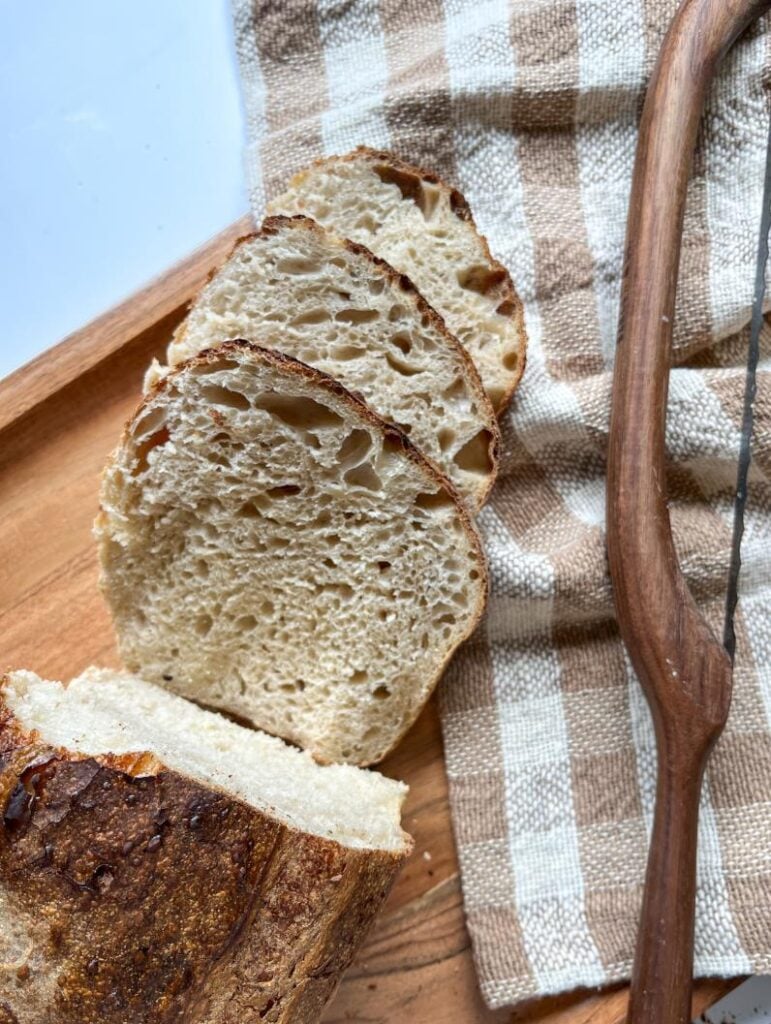
Helpful tools
- Kitchen scale: Using a scale to measure is much more accurate than using cups, plus it is easier to feed your sourdough starter!
- Loaf pan: Ideally you will want metal or aluminum to make your sourdough bread in!
- Large Mixing bowl: I recommend using at least a 4 qt mixing bowl, and I like to use glass so I can see the dough as it rises, but plastic or stainless steel also work.
- Bread Lame: This tool is used to score the top of the loaf. You can also use a really sharp knife, but the bread lame gives a cleaner cut.
- Danish dough whisk (use code CountryRoadsSourdough for 10% off): This specially shaped whisk is designed to easily mix the dough. You can also use your hands or a spoon, but I prefer to use this tool.
- Sheet pan: holds the ice on the bottom rack to make sure the oven is nice and steamy.
- Bread Knife: Slice your sourdough bread with ease. You can go for a traditional bread knife or a bow knife.
Take My Online Class
Ready to start making sourdough bread? My online class will teach you everything you need to know to make delicious artisan bread from home on any schedule and at any skill level. Set yourself up for success with clear, concise explanations, easy to follow recipes, and a few extra bonuses. Plus, get access to my private mentoring group, my eBook All Roads Lead to Sourdough, and some of my 100+ year old dehydrated sourdough starter (if you live in the USA).
How to make sourdough in a loaf pan
Step 1: Feed your sourdough starter
There are a few factors that can affect how your sourdough starter will rise, including the temperature of your house, how much you feed it, and how active it already is. Here are a few different feeding options you can do based on the timing in which you’d like to make your loaf.
1:1:1 ratio (1 part starter, 1 part flour, 1 part flour): This ratio will rise in about 4-6 hours
1:5:5 ratio (1 part starter, 5 parts flour, 5 parts water): This ratio will rise in about 12 hours
The starter is ready to use when it doubles or exceeds its size and becomes bubbly. If you can’t use the starter right away, you can store it in the fridge until you are ready.
Step 2: Mix ingredients
Add the flour, water, salt, and active starter into your large bowl and mix with a danish dough whisk, spoon, or your hand until it is incorporated and shaggy. Cover the bowl with a dinner plate (not a tea towel) and let it sit for 30 minutes.
Step 3: Stretch and fold
This step helps aerate and build strength in the dough. Ideally, you’ll do two or more sets of stretch and folds.
How to stretch and fold:
- After you let the dough rest for the initial 30 minutes, grab one side of the dough with a damp hand and shimmy the dough up, and then fold it on itself. Rotate the bowl 90 degrees and then repeat 3 more times.
- Re-cover and let sit for 20-30 minutes to let the dough relax.
- Repeat the stretch and fold one more time (a total of two times).
- If you have additional time, you can do 3-4 sets of stretch and folds (but no worries if you are in a time crunch!)
Step 4: First rise
Let the dough sit covered on the counter overnight for about 10-14 hours or until the dough rises about 75% but not completely doubled. You’ll know it is ready when the dough is aerated with bubbles showing on the sides and the bottom of the dough, and it jiggles when you shake the bowl. If the dough isn’t ready, let it sit in a warm spot and wait until you see these signs before moving on to the next step.
Step 5: Shape the dough
The good news is shaping isn’t as important when baking it in a loaf pan, so don’t stress.
How to shape:
- Dump the dough onto an unfloured surface.
- Gently spread the dough into a chubby rectangle.
- Gently pull the bottom of the dough up on top of itself, about ⅓ of the way, and then pull the other side of the dough up on top of both layers (folding it like a letter for an envelope). Pop any large bubbles you see.
- Starting from one side roll the dough on top of itself into an oblong shape and pinch the ends closed.
- With your hands cupped pull the rolled up dough towards your body to smooth out the surface.
- Using a bench scraper or your hands, gently lift the dough and add to the lightly greased loaf pan, seam side down.
Step 6: Second proof
Cover the pan and move it to the fridge for the final proof. Let the dough sit ideally for at least 8 hours up to 48 hours. The fridge slows down fermentation which allows the dough to sit for a longer time. The longer the dough sits, the more sour it will taste.
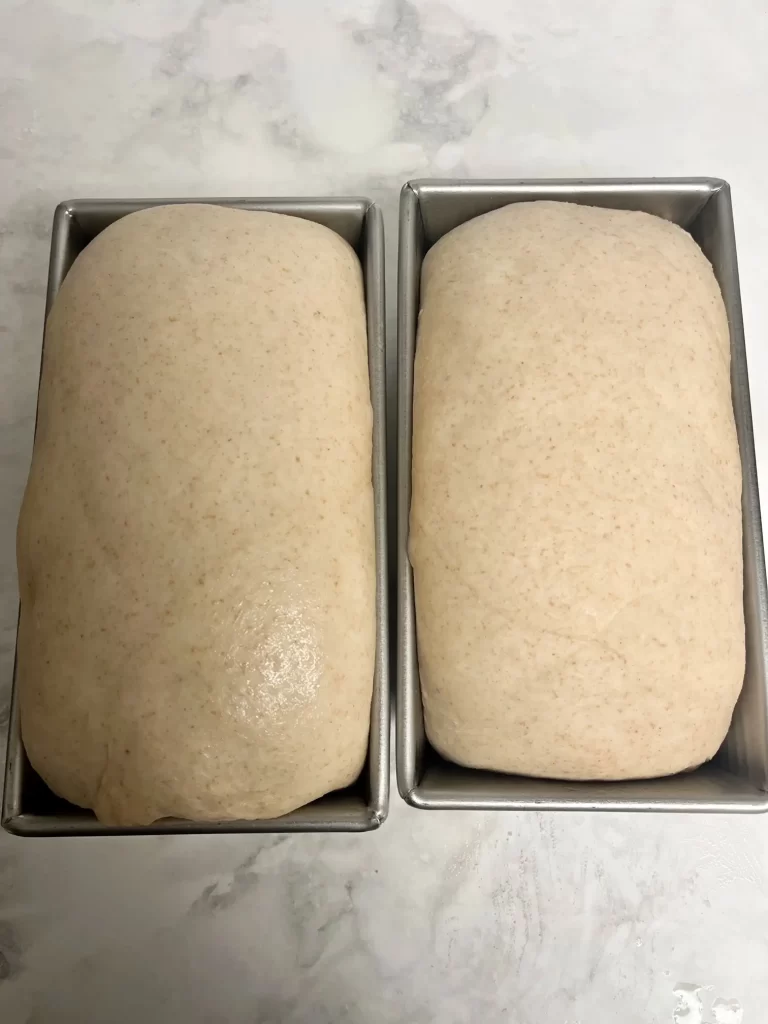
Step 7: Baking
When you are ready to bake, preheat the oven to 425F. Remove the pan from the fridge and score the top of the dough with your bread lame or sharp knife.
When the oven is preheated, add the pan to the oven and on the rack below, add a sheet pan with about 10-12 ice cubes on it.
After 20 minutes, remove the baking sheet and ice, increase the heat to 450F, and then bake for an additional 15 minutes. For a crispier, darker crust, remove the loaf from the pan for the last 5-10 minutes and place it on a cookie sheet or pizza stone to brown up. The loaf should sound hollow when baked through.
Once baked, remove the bread from the pan immediately if you haven’t already and let it cool on a cooling rack. I like to use my lanon heat protective gloves (use code countryroads15 for 15% off) to get the bread out of the pan easily.
When cooled, cut with a bread knife and enjoy!
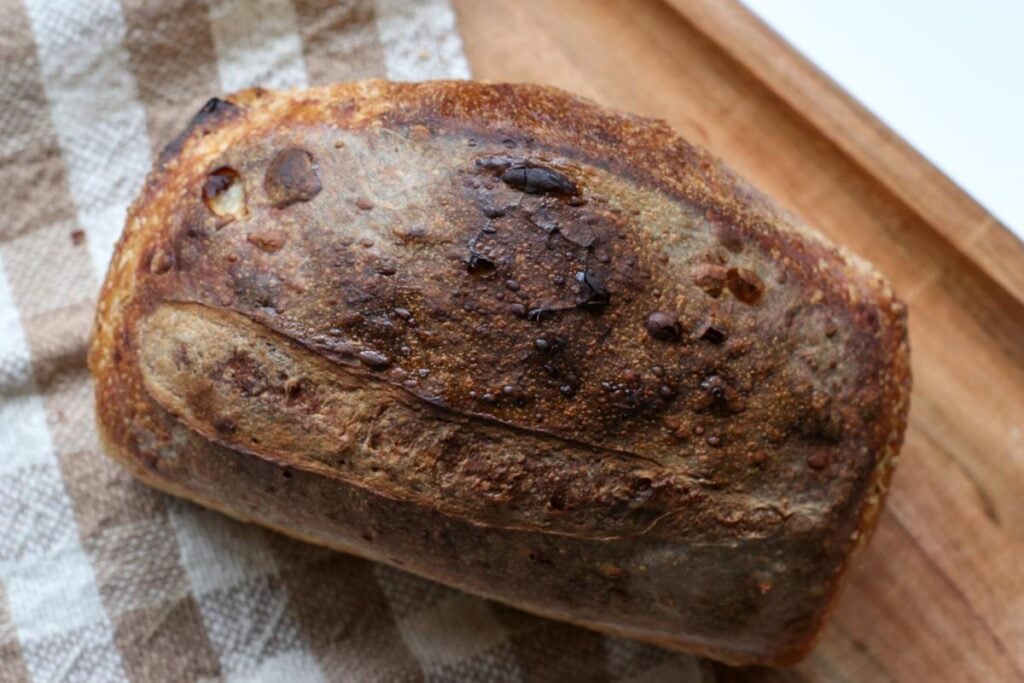
Sample Baking Schedule
This schedule is based on rough estimates but can help you get an idea of what your sourdough schedule will look like. The temperature of your dough, kitchen, humidity, and strength of the starter will all impact the times so while this will give you an estimate it is best to look at the signs the dough is ready to move on. There is flexibility with the schedule, so do what works best for you!
| Steps | Time |
| Feed sourdough starter 1:4:4 ratio (i.e. 10 g starter: 40 g flour: 40 g water) | 8 am |
| Mix dough | 7:00 pm |
| Stretch & folds | 7:30 pm-8 pm |
| Shape | ~7 am |
| Final proofing in fridge | 8 am-4 pm |
| Bake | 4 pm |

How to store and freeze loaf pan sourdough bread
You can store it on the counter with a tea towel over it for 2-3 days. After that, I recommend storing in a bread box or ziplock bag so the crust doesn’t go stale.
You can also freeze it to save for later! Add a whole, or half loaf to a freezer-safe bag and place in the freezer. To thaw, remove the bag from the freezer and let it defrost on the counter for several hours, or if you are in a pinch you can use the defrost setting on your microwave.
Once thawed, you can revive the sourdough by popping it in the oven to get the signature sourdough crispy crust again. Run the loaf quickly under running water and then place it in a 450-degree oven until the crust is crispy, about 10-15 minutes.
You can also freeze the loaf presliced so you can grab a slice or two at a time, just add a piece of wax paper or parchment paper in between each slice so they don’t stick together and then stick the loaf in a freezer bag.

Loaf Pan Sourdough Bread
Equipment
Ingredients
- 50 grams sourdough starter, doubled in size and bubbly, ¼ cup
- 500 grams bread flour, 3 ¼ cups
- 350 grams water, 1 ½ cups
- 10 grams salt, ½ Tablespoon
Instructions
- Mix together active starter, water, flour, and salt until a shaggy dough is formed.50 grams sourdough starter, doubled in size and bubbly, 500 grams bread flour, 350 grams water, 10 grams salt
- After 30 minutes get your hand damp and perform a set of stretch and folds. Cover and let rest. You now have 2 options: if you will be home and have time, add in 1 or 2 more sets of stretch & folds every 30 minutes or leave the dough to sit on the counter for the remainder of the time.
- Let the dough sit covered on the counter overnight for about 10-14 hours or until the dough is about 75% risen but not completely doubled. You’ll know it is ready when the dough is aerated with bubbles showing on the sides and the
bottom of the dough, and it jiggles when you shake the bowl. If the dough isn’t ready, let it sit in a warm spot and wait until you see these signs before moving on to the next step. - Now the dough is ready to shape. Prepare the loaf pan by lightly spraying it with a non-stick spray.
- Cover the pan and move it to the fridge for the final proof. Let the dough sit ideally for at least 8 hours up to 48 hours. The fridge slows down fermentation which allows the dough to sit for a longer time. The longer the dough sits, the more sour it will taste.
- When you are ready to bake, preheat the oven to 425℉.
- Once the oven is preheated, remove the pan from the fridge and score the top of the dough once vertically with your bread lame or sharp knife.
- Add the loaf pan to the oven on the top rack. On the second rack add a sheet pan with about 10-12 ice cubes on it and bake for 20 minutes.
- Remove the sheet pan, rotate the loaf and continue baking for an additional 15 minutes. For a crispier, darker crust, remove the loaf from the pan for the last 5-10 minutes and place it on a cookie sheet or pizza stone to brown up. The loaf should sound hollow when baked through.
- Once baked, remove the bread from the pan immediately, if you haven’t already, and let it cool on a cooling rack.
Notes
Nutrition
Nutrition information is automatically calculated, so should only be used as an approximation.
